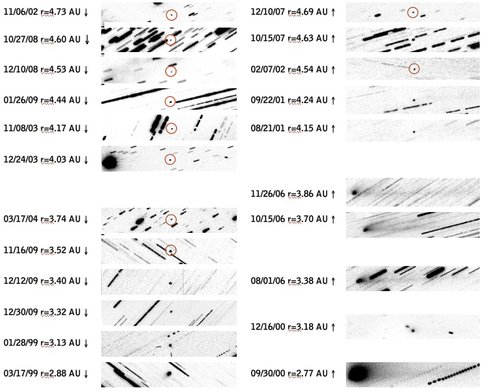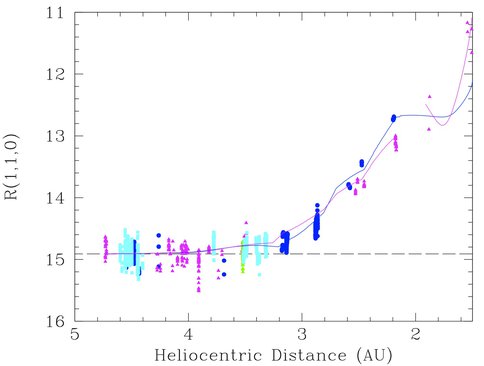2010 Annual Science Report
 University of Hawaii, Manoa
Reporting | SEP 2009 – AUG 2010
University of Hawaii, Manoa
Reporting | SEP 2009 – AUG 2010
Comparative Icy Bodies Studies Data Access Framework
Project Summary
We are developing a new database architecture and software to efficiently
access and archive terabyte-sized sets of small body (comet and asteroid) data
for long term studies relevant to thermal modeling, secular changes in activity,
composition and evolution. Ultimately this will will be instrumental when connected
with other large scale small body projects in the solar system (comet taxonomies,
dynamical studies) to understand the formation and evolution of the solar system.
Project Progress
We have completed a long-term (13 year) study of the behavior and activity of comet 9P/Tempel 1, in part in support of the Deep Impact and StardustNExT Missions. In this context a large optical imaging dataset was accumulated, and we have begun to model the long-term outgassing behavior of this comet. The data comprised 450 whole or partial nights from 14 observatories world wide, utilizing 25 telescopes. From this data we were able to evaluate when the outgassing from sublimating ices began and ended, and were able to detect secular changes in the activity of the comet. We noted that the presence of activity is not most sensitively detected through spectroscopic detection of gases, nor from the presence of the dust tail, but rather from the changing brightness of the comet as it approached and receded from the sun. One of the challenges for this project was handling the massive data. This is but one comet in 20+ year set of comet observations that can yield data for modeling which will greatly increase our understanding of small icy bodies. We are undertaking a project to develop a web accessible archive that will allow users to access the data, and the ancillary products and will prepare the data in an automated way for archiving into NASA standard archives.
The PDS (Planetary Data System) is a widely accepted archiving standard developed by NASA and used for data provided by space missions and all kinds of earth bound instruments. In order to be able to submit data into PDS, our observation data has to be organized into data sets and a lot of descriptive information that is machine and human readable has to be added to the actual data. This descriptive data includes PDS label files for each fits file, catalog files that describe the instrument the instrument host telescope location, and index files with the organization and structure of the data set. Typically, to each fits data file, a PDS compliant label file has to be created that describes in detail the content of the corresponding data file. PDS labels can be attached to the same file as additional header or be created as separate files in the same directory.
Software Development & Status
Creating labels by hand for more than a few files is not feasible and the official OLAF website for submitting data to the PDS Small Bodies Node has significant limitations because it was not designed to handle large sets. In order to keep maximum flexibility a UH specific software is being developed that will take care of the label creation.
A first version of the software is programmed and functional. It is organized very modular and can be easily extended. A first definition of labels files for comet related data (mostly Comet 9P/Tempel1) has been created and sent to the PDS nodes. A peer review by independent scientists and specialists of the PDS Small Bodies Node was performed in November 2011. The results from this peer review are very positive and only minor changes on the labels are required in order to achieve full archive readiness.
Comparison of the appearance of the target of the Deep Impact and StardustNExT missions
as the comet approached the sun and receded from the sun over the course of 3 perihelion passages. Although the data suggest that the volatile outgassing began near 4 AU inbound
and stopped near 4.5 AU outbound, from the images, a dust tail does not become apparent until
near 3.1 AU inbound, and disappears around 4 AU outbound.
Brightness (red-magnitude) corrected for geometry as a function of distance from the sun (in AU)
for comet 9P/Tempel 1 over 3 perihelion passages (shown in different colors). The next perihelion will be in early 2011. The solid lines represent simple water-ice sublimation models and can match the activity of the comet inbound, with the first activity beginning near 4 AU. A decrease in the
amount of outgassing (and brightness) is seen from the 1999 to the 2005 perihelion passages.
-
PROJECT INVESTIGATORS:
-
PROJECT MEMBERS:
Karen Meech
Project Investigator
Timm Riesen
Project Investigator
Jana Pittichova
Co-Investigator
-
RELATED OBJECTIVES:
Objective 1.1
Formation and evolution of habitable planets.
Objective 2.2
Outer Solar System exploration

